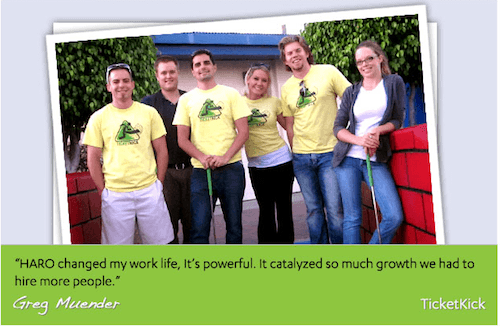Is There Really Such a Thing as a Good Pitch? (Resounding “Yes,” Please!)
Note: I do NOT receive any payments for writing and publishing articles about HARO. I think HARO is a great resource to use and wanted to share some insight into how best to use from our experience and other’s insight.
Let’s be honest – HARO (Help A Reporter Out) is a godsend for media members, PR pros, small businesses and entrepreneurs around the world. If you’re not using it, you’re simply batty. If you didn’t know about it before now, I’ll ask that you get your head out of your business plan and check it out. No, really – pardon my candor but it really is that great.
In the case that you haven’t heard of it – I’ll break it down for you. HARO is a free service that lets media members discover the perfect sources for their stories. For subscribers (PR pros, small businesses and entrepreneurs), HARO directly connects you with these media members. All you need to do is sign up as an email subscriber, review the opportunities and start pitching yourself as a source for relevant stories.
Maybe you’ve tried HARO and didn’t see results, or maybe you did. As writers and publishers at freelancemom.com, we use HARO often to find the perfect sources in order to deliver the best information to our readers. With that said, we’ve seen a lot of really awesome pitches, and a lot of pitches that make our faces twist into an odd contortion. So we compiled a list of our personal first-hand tips on HARO pitching, as well as spoke with others who’ve met success. So without further ado, here’s the science behind HARO pitching.
Think Outside of the Box
Be open-minded when scanning the opportunities. Consider everything you or someone else in your company could offer insight into. For example, if you own an e-store but see a query about American families and the balance between work and family and this is something you struggle with, pitch yourself! That reporter will more than likely name your business in the article if you make it part of your key messaging. Every piece of coverage and every link to your business adds up.
Do Research
If the reporter provides an outlet and name, do some quick research on the reporter’s articles to see what type of language he/she uses, what his/her personality is like and what types of sources he/she typically quotes. Try to match your pitch to align with his/her style.
Be Quick
The life of a reporter means always having urgent deadlines. If you respect that fact and check the HARO emails right when they come out, you can be among the first to respond, increasing your chances of getting coverage.
Write like a Journalist
Journalists and bloggers are some of the busiest people ever. So they truly appreciate when you make their work easier on them. Make it simple for them to plop your response into their article if needed. Believe it or not, sometimes they’re so busy they don’t have time to pick you as the star for an interview. Sometimes, they may just grab a snippet of your pitch for their article.
Be Concise
Quite possibly the most important aspect of pitching a query is answering it succinctly. “Make things easy to read and to the point,” said Kelsi Byers, public relations coordinator at Remote Stylist, who has garnered extensive coverage for her company through HARO. “Underline and bold important points to make them stand out. You want the reader to be able to scan for main ideas. They get tons of responses and don’t have time to read them all.”
Don’t Shamelessly Self-Promote
This is so, so important! Plenty of times we receive lengthy emails where we have to hunt for the information we asked for because it’s not included until after all of the self-promotional language. And let’s be real here, most reporters get sick to the stomach when they read all that language that they won’t even read past it. Sure, a little self- endorsement is okay, but only if it helps answer the query. And do yourself a favor by putting it at the end of the pitch.
Answer the Query
Believe it or not – we get pitches that say things like “Hi. My name is so and so. I can offer you some great tips on (insert topic) because (insert self-promotional language). Contact me if you’re interested.” You know what I say to that? Unless you’re Steve Jobs reincarnated – I’m hitting delete. For one, I don’t have time to hunt you down for information. It was your job to sell me on that from the beginning. Do yourself a favor and spend time crafting the pitch, and answer every question asked of you.
Offer Fresh Insight
In addition to answering each question, it’s important to answer each with a fresh perspective. Don’t reply with mediocre answers because guess what? There are 20 other people pitching the same thing. Increase your chances of getting covered by offering innovating thinking and unique perspectives.
Be Genuine, Professional and Grateful
Please keep in mind throughout your pitching that reporters are human beings. Just like anyone else, they deserve respect, professionalism and appreciation. Be cordial in the opening and closing of pitches but don’t treat them too formal either. Just treat them like colleagues. And of course, if they do decide to use you as a source, make sure to share on all of your channels as well and thank them for the coverage. In addition, if you do get covered, it’s okay to let them know that you’re available should they ever need information on (insert subject). They’ll appreciate the offer if you’ve already helped them out with a great story.
Write Sound Bites
As important as it is to answer the query exactly how they asked for it, it’s also important to make it work for the benefit of your company. Any reference to you or your business is great, but key messaging-infused sound bites are even better. In addition to piquing the reporter’s interest, they can help get more of your messaging into the article.
Have Your Quotes and Sources Ready
Going along with the “reporters are always on deadline” reality, it’s important to have quotes and sources ready in case the reporter pings you right back with a request. If you’re not prepared, they’ll find somebody else. So when you pitch, know your key messaging and what you’re going to say if they email you back, be available when they need you and if you’re offering a source other than yourself, make sure that person is available.
Use a Boilerplate
At the bottom of the pitch is where you can fit in promo language within a boilerplate format. Boilerplates show your area of expertise and illustrate that you are a credible source. According to Kyra Mancine who handles copywriting, PR and social media at QCI Direct, you should include each HARO success or other coverage in the boilerplate to show that you’ve provided other outlets with worthy coverage. “Each HARO success story adds credibility,” she said. “When you get a hit, use it to get the next one.”
Check Grammar
If there’s anything reporters hate the most, it is incorrect grammar and spelling mistakes. They have a trained eye for it and not much patience for coming across it in pitches. I’ve even heard of reporters emailing a spelling mistake back to the person who pitched the story. The lesson? Check, check and recheck. Edit it once, have someone else edit it and then edit it again. Don’t rely on Microsoft to do it for you.
Ask That They Share the Article
Some reporters are so busy that they’ll run out of time to tell you that they used your pitch in a story. It’s important to do some sort of online monitoring, such as with Google Alerts, to alert you of coverage. If you do find coverage that the reporter never told you about, be sure to send a follow-up email to thank them. However, when you’re sending an initial pitch, it is okay to mention that you’d enjoy sharing the article with your followers once it’s published. This is a nice way of asking that they alert you if they use you as a source.
Share with HARO
The HARO Facebook page has over 34,000 loyal followers (I told you it was hot!). What better way to promote your coverage and your business than by sharing it on the HARO Facebook page? According to Mancine, you should also tweet to HARO on Twitter with a link to the article and post on LinkedIn, thanking them for hooking you up with a great opportunity.
Pitching HARO takes a bit of time to master, but it’ll be a good deal easier if you follow tips and tricks from HARO veterans. Mancine notes that her success rate is around 15% with HARO and her employer is very pleased. “Other than the time commitment,” she said. “HARO is an extremely cost effective way to promote a business, especially ones without a big budget.” Who knows, with some active HARO pitching, your name might end up in Entrepreneur sooner than you think.






